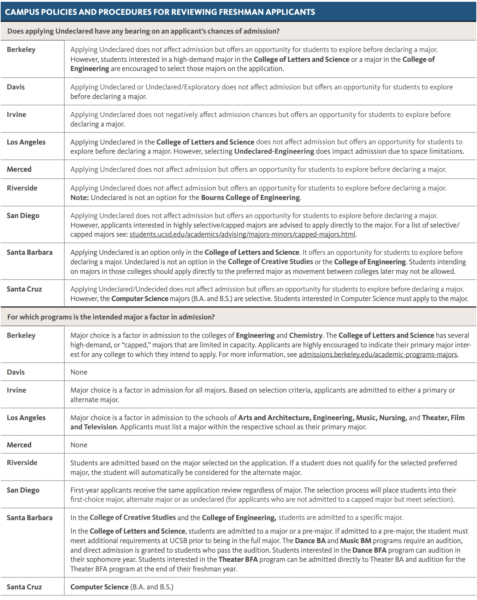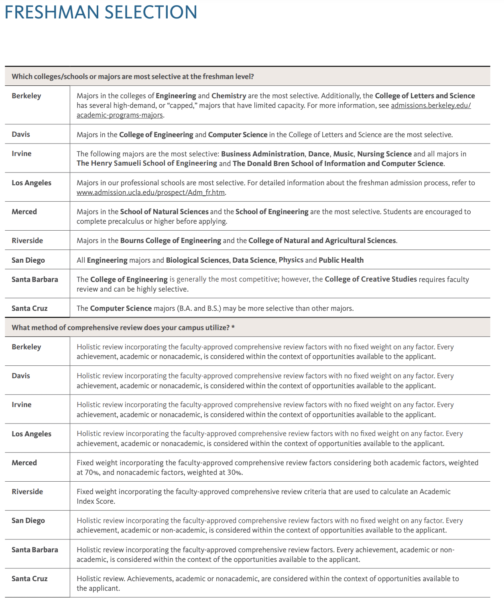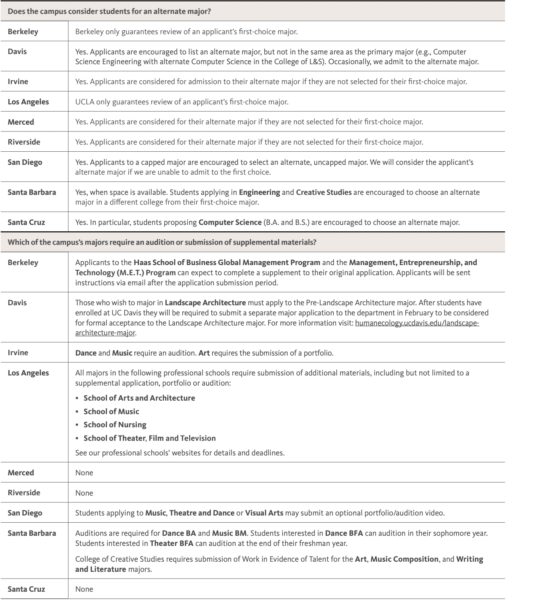Steps to Completing your UC Application:
Materials You Need: You will need a copy of your transcript, test scores (AP/IB), social security number (optional), CA statewide Student ID (for public HS students) and a credit card. It is best to complete the application in sequential order. There is a help feature in the top right-hand corner of the application.
Understanding Comprehensive Review: Using a process called comprehensive review, evaluators look at multiple factors beyond courses and grades to evaluate applicants’ academic achievements in light of the opportunities available to them and the capacity each student demonstrates to contribute to the intellectual life of the campus. If you are interested in how each campus reviews applications and the factors they are considering, look on the Comprehensive Review Page for campus-wide information and then click on each campus on the right-hand side to see the specific information for each school.
Transcripts: You do not need to send a transcript to any UC schools. You do need a copy for yourself to self-report your grades on the application. Most of your classes will be pre-populated and use a drop-down menu. However if you have a class that does not come up, we recommend going to the UCOP Doorways website to see the course listings for your school. This will help you determine if the class should be added and if so the appropriate A-G category. You do not enter Life Skills, World Studies 1(2.5 credits), or PE (unless it is dance). **** If you take PE dance or Advanced Dance at a public school and you get quarter grades, you must check both quarters and semesters when you enter your high school in the application. Enter all courses as they appear on your transcript.
Test Scores: You can report your AP/IB subject tests and future tests. In this section, there is also a button to click if you are planning to complete the full diploma. You do not report your SAT/ACT score unless you are an ELL student.
Extra Information on the Application: Maximizing the use of the “Additional Comments” sections.
Applicants can use the first additional comments box, following the “Academic History” section, to explain their course selection decisions, a circumstance that prevented the student from taking more rigorous courses, gaps in education, differences in terms or grading systems, or a situation that affected their grades.
The second comment area immediately follows the “personal insight questions” section. Applicants may choose to provide information about a learning difference, circumstances or opportunities that had a significant impact on their educational journey, or uncommon events that provide context for what they’ve accomplished or was unable to accomplish.
The two additional comments boxes in the application are optional and should not be used as a continuation of a student’s personal insight question responses. Instead, students should use this section to explain anything that has not been discussed in other parts of the application or might benefit from further clarification.
Designating a Major: Every year students stress over designating a major or choosing “undecided” on the UC application. The good news is students can choose different majors at each campus to which they apply. The bad news is that each school in the UC system deals with major selection slightly differently. To do a UC system majors check, click here so you can see what campuses offer majors that you are interested in choosing and which majors are closed. Below you will find the quick reference guide for each school related to majors answering the following questions:
- Does applying Undeclared have any bearing on an applicant’s chances of admission?
- For which programs is the intended major a factor in admission?
- Does the campus allow students to apply to an alternate major?
- Which of the campus’s majors require an audition or submission of supplemental materials?
- Which colleges/schools or majors are most selective at the freshman level?
- What method of comprehensive review does your campus utilize?



The best thing students can do is go to the website of each individual campus to determine what role major plays in admissions. The school names below are hyperlinked to individual school websites and also the major options.
RIVERSIDE Major options at UCR
SAN DIEGO Major Options at UCSD
SANTA BARBARA Major options at UCSB
SANTA CRUZ Major options at UCSC
Revising the Activities Section: The UC application allows you to enter up to 350 characters to describe your activities. You can take your activity descriptions from the Common App and turn them into complete sentences (without ampersands and other tricks we used to cut down the word count). Then we recommend adding a sentence that explains why the activity is important to you or what skills you have gained through your participation. For community service and work activities, you will also have an additional 250 characters to describe the organization. This is a chance to give the reader more knowledge about the organization and your involvement.
Helpful Videos: UCSB has a wonderful collection of videos explaining the different parts of the UC Application. We recommend students watch each video before they complete each section.
UC Application Part 1: Creating Your Application
UC Application Part 2: About You
UC Application Part 3: Campuses & Majors
UC Application Part 4: Academic History
UC Application Part 5: Test Scores
UC Application Part 6: Activiites and Awards
UC Application Part 7: Scholarship Section
UC Application Part 8: Personal Insight Questions




